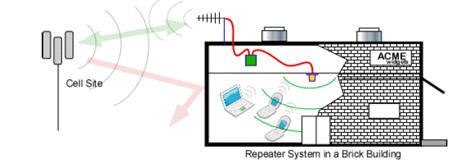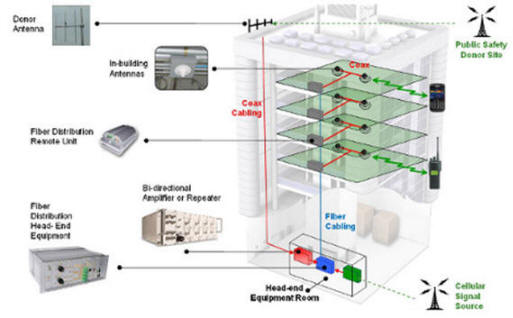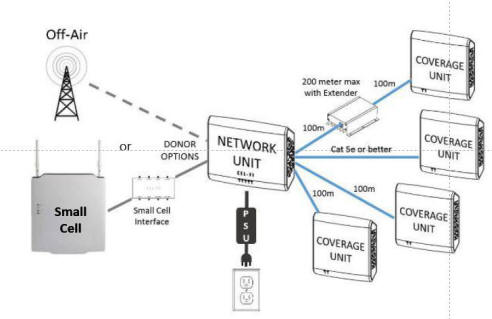|
A DAS is the
distribution of
cellular Radio
Frequencies (RF) to
a network of
antennas within a
building to provide
cellular coverage
for today's Smart
Phones and Tablets.
The DAS distributes
the cellular radio
frequency signals
from a centralized
radio source
throughout the
building using a
network of RF
coaxial cabling,
splitters, couplers
and antennas, fiber
optic cabling and RF
repeaters. The aim
is to create an
indoor coverage
layer seamlessly
integrated with the
outdoor macro layer
and handling all
voice and data
traffic internal to
the building,
offering better
quality and user
experience.
DAS solutions can
be classified as
passive, active, or
hybrid systems.
 Passive DAS
Implementation
Passive DAS
Implementation
Passive
DAS: In
passive systems, the
wireless signal from
the RF source is
distributed to the
antennas for
transmission,
through a series of
passive components.
Passive DAS is
normally implemented
using
passive splitters,
antennas and a
bi-directional
amplifier or
“Booster”. The
cellular signals
from multiple
carriers are
normally "boosted".

Active DAS
Implementation
Active
DAS: In
active DAS, the
cellular signal may
be provided by a
carrier directly
over a fiber
connection, or, may
be captured by a
rooftop antenna and
converted to a
digital signal for
transmission over
fiber optics or CAT
5e/CAT 6 cable. The
signal is then
amplified by
bi-directional
amplifiers and
distributed over
coax to the
antennas. Active DAS
installations are
normally single
carrier systems that
must be reviewed and
approved by the
carrier prior to
implementation.
Multiple carriers
require the
installation of
multiple systems.
 Hybrid DAS
Implementation
Hybrid DAS
Implementation
Hybrid
DAS: A
hybrid active DAS
system is a
combination of
passive and active
systems. In a hybrid
DAS system, CAT5e
cable is used to
connect the head end
or network unit (NU)
to the remote
coverage units
(CUs). However,
passive DAS may be
used for additional
distribution of the
RF cellular singnals
to additional
antennas connected
to the remote
coverage units. The
head end or network
unit can receive the
carriers signal from
an outdoor antenna
over coax or from a
carrier's Small Cell
device. The mall
Cell device receives
the carrier's signal
over fiber or coax
from the Internet.
The hybrid system
avoids the signal
loss experienced
with coaxial cable.
Hybrid DAS
implementations are
pre-approved by the
carriers; thus,
there are no
approval delays.
Contact Us for a
DAS Quotation:
RHO
Wireless
6804 Genstar Lane
Dallas, TX 75252
972-985-0485
Sales@rhowireless.com
|